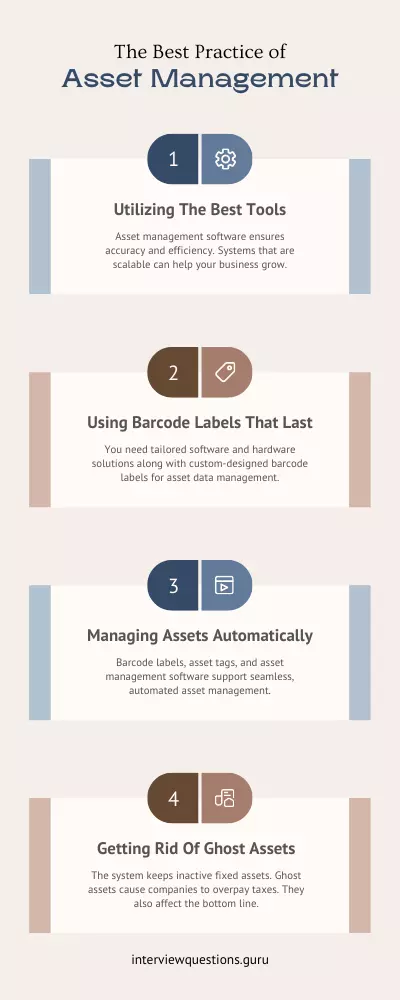IT Asset management is a critical process for businesses and organizations. When done correctly, asset management can help improve efficiency, optimize resources, and reduce costs. This blog post will provide some common IT asset management interview questions and answers.
Table of Contents
IT Asset Management Interview Questions and Answers
What is asset management in ITIL?
ITIL defines asset management as “a strategic process that ensures investments in IT assets are optimized throughout their lifecycle to meet the ever-changing needs of the business.” In other words, asset management is all about making sure that your organization’s IT infrastructure can support the changing needs of the business.
What are some standard features of an asset management system?
Some standard features of an asset management system include:
- A centralized database to store and track information about assets
- The ability to schedule and track maintenance tasks
- Integration with other business systems (such as accounting or ERP)
- Reporting tools to help make informed decisions about assets
What do you mean by asset?
An asset is anything that has value to your organization. This can include physical items like computers and office furniture and intangible assets like software licenses and website domain names.
What is Configuration Management?
Configuration management is the process of managing the configuration of assets. Configuration management can include keeping track of asset versions, assigning unique identifiers to assets, and storing asset information in a central repository. Configuration management is important because it helps businesses keep track of their assets and ensure that they are using the correct versions.
How can asset management help my business?
Asset management can help improve efficiency by reducing the amount of time spent searching for assets, optimizing utilization of assets, and automating tasks like maintenance scheduling. Additionally, asset management can help reduce costs by improving asset purchases and usage visibility.
What are some common challenges with asset management?
Some common challenges with asset management include maintaining accurate and up-to-date information about assets, keeping track of asset location, and managing the growing number of assets as your business grows.
What is the best way to get started with asset management?
The best way to get started with asset management is first to assess your organization’s needs and then find a vendor that offers a solution that meets those needs. Once you have selected a vendor, you will need to implement the asset management system and train your staff on how to use it.
What are the key processes of IT asset management?
The key processes of IT asset management include:
Asset discovery: This is the process of identifying all of the assets in your IT infrastructure.
Asset tracking: This is the process of keeping track of the location and status of each asset.
Asset maintenance involves scheduled tasks like software updates and patching to keep assets in good working condition.
Asset disposal: This is the process of safely disposing of no longer needed assets.
What are some common asset management terms?
Some common asset management terms include:
Configuration item (CI): A configuration item is an individual component of your IT infrastructure.
Configuration management database (CMDB): A CMDB is a database that stores information about all of the CIs in your IT infrastructure.
Asset: An asset is anything that has value to your organization. This can include physical items like computers and office furniture and intangible assets like software licenses and website domain names.
Asset tag: An asset tag is a unique identifier that is assigned to each asset.
Location: The location of an asset is the physical address where the asset is located.
Status: The status of an asset indicates whether or not the asset is in working condition.
Maintenance: Maintenance is any scheduled task performed on an asset to keep it in working condition. This can include tasks like software updates and patching.
Disposal: Disposal is the process of safely disposing of assets that are no longer needed.
How often should assets be audited?
The frequency of asset audits will depend on the size and complexity of your IT infrastructure. For small organizations, an annual audit may be sufficient. For larger organizations, it may be necessary to conduct audits more frequently.
What is some common software used for asset management?
Some common software used for asset management include:
ServiceNow Asset Management: ServiceNow Asset Management is a cloud-based solution that offers a complete asset lifecycle management solution.
BMC Atrium CMDB: BMC Atrium CMDB is a database that stores information about all of the CIs in your IT infrastructure.
SolarWinds Network Configuration Manager: SolarWinds Network Configuration Manager is software that helps you manage your network devices and configurations.
Give some best practices for IT Asset Management?
Some best practices for IT asset management include:
- Regularly auditing your assets to keep track of their location and status.
- Implementing a software solution to help you manage your assets.
- Training your staff on how to use the asset management system.
- Creating procedures for disposing of assets that are no longer needed.
What is Depreciation in IT Asset Management?
Depreciation is allocating the cost of an asset over its useful life. This is important for financial reporting purposes as it allows organizations to spread the cost of an asset over time. Depreciation is typically calculated using one of two methods: straight-line depreciation or declining balance depreciation.
What is Ad-hoc reuse?
Ad-hoc reuse is the process of reusing assets in a way that is not planned or controlled. This can happen when someone finds an asset that they think would be useful for their project but does not go through the formal process of requesting it from the asset manager. Ad-hoc reuse can lead to problems, such as asset duplication and inconsistency. Therefore, it is important to have a process to request and approve assets for reuse.
What are some benefits of asset management?
Some benefits of asset management include:
Improved decision making: Asset management can help you make better decisions about allocating your resources.
Increased efficiency: By having a complete picture of your assets, you can avoid duplication and improve your overall efficiency.
Reduced costs: You can reduce your overall costs by disposing of no longer needed assets.
Improved compliance: Asset management can help you ensure compliance with regulatory requirements.
What is a Robust asset?
A robust asset is an asset that is resistant to changes in the environment or market conditions. Robust assets are often less volatile and more predictable than other assets. This makes them an attractive option for investors who are looking for stability. Robust assets can include bonds, real estate, and precious metals.
What are Stockrooms?
Stockrooms are rooms where inventory is stored. Stockrooms are usually located near the production area so that stock can be easily accessed when it is needed. Stockrooms are typically organized using a first-in, first-out (FIFO) system. This means that the oldest stock is used first, and the newest inventory is stored at the back of the stockroom. Stockrooms are typically secured to prevent theft or loss.
What is WIP?
WIP stands for work in progress. WIP is inventory that has been started but is not yet completed. WIP can include raw materials, partially finished products, and products that are being assembled. WIP can be frustrating for managers because it ties up capital that could be used elsewhere. WIP can also lead to problems with quality if it is not managed correctly.
What is obsolescence?
Obsolescence is the state of being outdated or no longer helpful. Obsolescence can happen when a product is no longer produced, when technology becomes obsolete, or when a change in consumer behavior makes a product less desirable. Obsolescence can be a problem for businesses because it can lead to the loss of customers and revenue.
What is Disposal?
Disposal is getting rid of assets that are no longer needed. The disposal can happen through sale, destruction, or donation. Disposal is important because it can help businesses reduce costs and improve compliance with regulatory requirements.
What do you mean by Procurement?
Procurement is the process of acquiring goods or services. Procurement can be done through purchase, lease, or rental. Procurement is important because it allows businesses to obtain the resources to operate.
What is Asset Tracking?
Asset tracking is the process of tracking the whereabouts of assets. Asset tracking can be done manually or electronically. Asset tracking is important because it helps businesses keep track of their assets and ensure that they are correctly used.
Conclusion
We hope that these IT Asset Management interview questions and answers have been helpful. Asset management is a critical process for businesses, and it is to make sure that you have a good understanding of the basics before you start your career in this field.


Thanks for Information, Request you please share the difference between
Asset Management and Asset Governance